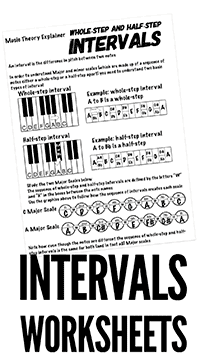Download Free music theory lesson plans and learning packs
Although the download contains many resources aimed at intermediate or advanced students such as handouts on Seventh Chords or Blues Scales along with a range of Guitar Resources one of the most useful elements of it are a series of twelve "learning packs" targeted at those of our students who either have no "joined up" knowledge with regard to how music theory works or who have significant gaps in their knowledge
As you scroll down this page you will have the opportunity to download a FREE PDF outlining (in much greater detail than we can do here) a series of music lesson plans devised for Middle and High School music classes designed to take a student from a situation in which they have no functional knowledge of music theory to place where they have a "joined up" knowledge of note naming, intervals, scale construction and how scales and chords allow us to understand keys
A complete Music Theory Course in 12 Lesson packs
The following ready made learning packs (with answer sheets also included in the download) can be used as regular classroom resources
You can also upload the packs to your school or college IT system so that your students can use them for revision or home study purposes
Classroom and Online Music Theory Learning Packs
In response to the changing ways in which many of us have been forced to teach in recent times some of the classroom resources have been compiled into a series of distance learning packs designed to take students from a "standing start" to a situation where they understand note names, intervals, scales, chords and keys
The packs (one of which you can download FREE from this page) come down as single multi-page PDF documents covering the following topic areas....

Pack 1: Note Names 1
One "Explainer" and three worksheets on naming notes correctly. The first worksheet covers the notes to be found under the white keys of a piano while the other two introduce the sharp and flat notes located under the black keys
Download and print a FREE PDF of the Note Naming "Explainer" Document shown
You can use and distribute the "explainers" during the course of your classroom lessons You can also put them on the wall of your music class room and direct students to them during lesson/workshop sessions
The materials on this site (worksheets "explainers" etc) can also be uploaded to school or college systems so that students can download them to their own devices for home study or revision sessions

Pack 2: Note Names 2
This pack is designed to reinforce and develop the principles covered in the first pack. It contains the "explainer" again and two more worksheets on note naming. The aim is to have ou students be able to name any note on the keyboard without having to refer to the "explainers" It should be stressed that "knowledge is no good if it stays on the paper" When our students can name notes correctly then they are ready for study of whole and half step intervals
Get an answer sheet for the note naming worksheet above
All of the worksheets in the twelve learning packs have answer sheets to accompany them You can get the answers to the questions posed in the worksheet by following the link in the box below

DOWNLOAD THIS PACK FREE!
FREE DOWNLOAD Pack 3: Whole and Half-Step Intervals 1
An "explainer" and two worksheets looking at whole-step and half step intervals that students will need to understand before they can construct Major and minor scales. As well as being required to graphically recognise and represent individual notes learners are then required to provide the names of notes a whole or half step above or below the one that they originally identified. You can download this pack as a freebie to let you see the quality of our materials and to see where they may fit into your own teaching practice
Download and print this Music Theory Teacher's Pack Free!
To give you an idea of how simple the learning packs are to use you can download the above pack free. Our full download contains 11 more of these learning packs as well as answer sheets for all of the exercises

Pack 4: Whole and Half-Step Intervals 2
Above you can see a detail of one of the worksheets in this learning pack
Another copy of the explainer and two more worksheets to support this crucial aspect of learning how music theory works. When students develop an understanding of whole-step and half-step intervals they are ready to combine the sequence of those intervals that go to make up any major scale

Pack 5: Major Scale construction 1
A Major Scale "Explainer" and two worksheets that build upon the knowledge of note naming and a learner's understanding of intervals to create Major Scales

Pack 6: Major Scale Construction 2
Above is a detail taken from one of the worksheets from the pack
The explainer and two more worksheets designed to ensure that learners can construct any Major Scale
Download and print more than 400 PDF Music Worksheets and Handouts
to use year after year
for less than the cost of a
single Paper Based Textbook
$18.00

Pack 7: Minor Scale Construction
The minor scales "Explainer" and two worksheets looking at the (different) sequence of whole-step and half-step intervals that will allow our students to identify the notes in any minor scale

Pack 8: Major and Minor Chords 1
Two "Explainers" (one each for Major and minor chord construction) and a worksheet looking at the difference between Major and minor chords

Pack 9: Major and Minor Chords 2
The Explainers again and two more worksheets designed to reinforce knowledge of Major and minor triads

Pack 10: Chords and Keys (Diatonic harmony) 1
An "Explainer" and two worksheets related to it that look at all of the chords (built from the same Major Scale) that can be found in a particular key. This is the first of three learning packs that look at the principles of Diatonic Harmony
The materials presented at this stage of the programme are particularly suitable to be used alongside our Guitar Music Theory resources

Pack 11: Chords and Keys 2
The explainer again and three worksheets looking at how the chords within a key work

Pack 12: Chords and Keys 3
The final pack with four more worksheets looking at the diatonic system


Answer Sheets for All Of The "Early Stages" Worksheets
Above you can see some of the answer sheets that come as part of the download dealing with all of the topics from note naming through whole and half step intervals, Major Scales, Major and minor triads and how those chords combine to give us keys. They are ideal for homeschool and distance learning situations
The First High School Music lesson Plan

The "The "Rules" of Note Naming Explained
By the end of this lesson ALL students will be able to tell you the name (or choice of names) for any key on a piano. They will understand the concepts that govern sharp and flat notes and they will be ready for the next stage which is the study of whole step and half step intervals
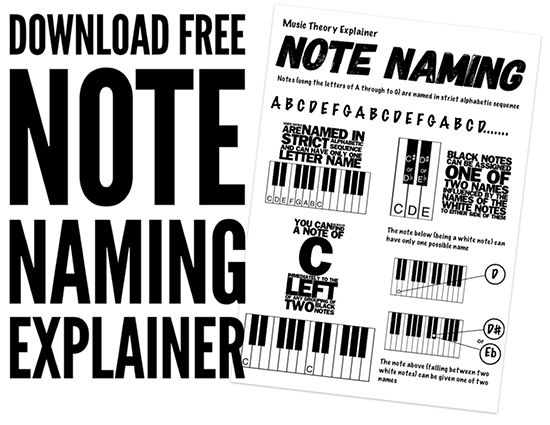
Below you can see the student handout that you can download to go along with this introductory music theory lesson. The PDF also (along with our other handouts-rather than worksheets) makes a great "quick reference" wall chart for your music teaching room
Why study note naming first?
This introductory music lesson plan is concerned with having High School music students develop the ability to Name Musical Notes Correctly ,/p>
because...........
"If our students can not assign note names correctly then they will be unable to develop a functional knowledge of music theory"
If our students cannot correctly name notes then they can't understand intervals?
If our students do not understand intervals (of a whole and a half step anyway) then they can't understand scales
Without an understanding of scales then learners can not develop a "joined up" knowledge of chords and how they are constructed.
Without being familiar with chord construction then they can not be expected to have a workable understanding of how the chords that can be constructed using only the notes of a single "parent scale" can combine to give a "pleasing" effect.
Getting "The Basics" Right
As music educators we would do well to make sure that all of our students understand the absolute basics because any lack of understanding here will "haunt" their learning as they move on to more involved musical material.
Particularly in the early stages of a programme we need a series of effective music lesson plans designed to help us to indentify (and eliminate) problems that our students might have with music theory
Music Lesson Plans
The following material looks at how a series of music lesson plans might be used in a way that will ensure that students attain a level of understanding of the various elements of music theory allowing them to progress easily to the next stage of study?
"The subject is more important than the syllabus
It is important to remember that "The subject is more important than the syllabus" and we should design our teaching programme around that simple fact? If our students understand the elements of music and how they work together to create "magic" (and radio jingles) then it should be a relatively easy process to make that fit into key stages for our internal documentation etc? This site is about the music and not the key stages (or whatever) that it is currently (and artificially?) broken up into.
The material presented beow and which is complemented by the music lesson plans PDF that you can download by clicking the link above has been broken up into "topics" rather than lessons simply because of the varaibles involved in the lesson planning and teaching process. These variables include such factors as class size and the length of each session as well as areas such as the age, ability range and prior learning/experience of the student group?
High School Music Theory Lesson Plans Topic 1:

(above) Note Identification Chart and related worksheet
Correctly Naming Musical Notes
The free worksheet that you can download from the link above concerns itself with helping students become able to identify any of the white (natural) notes on a piano keyboard. Of course we also have a whole range of similarly themed sheets in our "one click download" that cover the choice of note names involved in keys other than C Major where notes found on the black keys are involved
The worksheets and Handouts in action
Above (behind the worksheet) you can see of the simplest handouts imaginable which simply identifies a single octave of notes to be found on a piano keyboard but the truth is that if our students can't correctly name notes then they stand no chance of learning how music theory works? Even though they may have no piano skills (and maybe no need of them?) the fact remains that the piano keyboard still provides us with the best and most easily understood graphic representation of "how music works"
The handout above is simply a full page diagram of the keyboard with the names of the notes on it through one octave.In addition to supplying a paper copy to their students many teachers choose to laminate this handout and display it on the wall of their music room for "quick reference"
The Music Worksheet pictured alongside it is one of a series of five designed to help our students to develop the ability to assign the correct name to any note
Music Teachers can use the material above to help our students to understand the principles that underpin the correct naming of musical notes.
Musical Note Naming Lesson Plan
and an invaluable free "explainer" to download
This music lesson plan revolves around three important principles or concepts that it is vital to get our students to understand if they are to develop a functioning and useful knowledge of music theory. These three outcomes can also be used when it comes to filling in "lesson objectives" or whatever they call them where you live in order to satisfy those (administrators and inspectors) who help us to adopt "best practice" (or depending on your viewpoint who dont trust us to do our jobs properly)?
Anyway (rant over!).........
The three "Big Ideas" that classroom music teachers will find useful to bear in mind when using the material with their students are......
"Big Idea No 1"

White Notes can be assigned only a single note name using the alphabetic sequence from A to G
"Working from the known to the unknown" was all the rage when I was going through teacher training and its still a great way to "demistify" subjects like music theory. Your music students will be secure in their knowledge of the alphabet from A through to G and they can use this to understand the absolute basics of music theory
"Big Idea No 2"

Black notes can be given one of two names determined by the white notes that are to be found at either side of them. They will soon get used to the idea that if you can use the names of the white notes to provide you with a choice of names for the black ones.
"Big Idea No 3"

You will always find a note of C immediately to the left of any grouping of two black keys on a keyboard.
By the end of this first lesson it is a good idea to have your students work on being able to remember the "Three Big Ideas" without recourse to any bits of paper (which is a shame for me as I am trying to sell you a package that allows you to print 300 bits of paper!)
There is a free lesson plan that you can download by clicking the "download lesson plans" image on this page that goes into this introductory material in much greater detail than there is the opportunity to do here
Divide the lesson into two parts
I find that an effective way to have students progress with this material is to divide the session into two sections. During the first part of the lesson worksheets are distributed and students are required to fill them in with access to the "note naming handout" shown above.
I then collect the worksheets in and take a quick look at them. The reality is that just about everyone will get them all right (not a waste of time though as its a great way to build confidence)
Knowledge of Music Theory is no good if it stays on a piece of paper!
After taking a quick look at the completed worksheets(and because I love a bit of theatre!) I get the group's attention and then tear up the worksheets that they have just completed in front of them (sometimes this can create genuine outrage - its fun).When the grumbling has died down it provides an opportunity to discuss the notion that "The knowledge is no good if it stays on a piece of paper?".
We are not trying to create a situation where people can find things out if they need to in order to fill a worksheet in (we already have google for that?).
During this lesson we are trying to ensure that by the end of it our students are capable of assigning a name (or potential choice of names) to any note on a piano keyboard
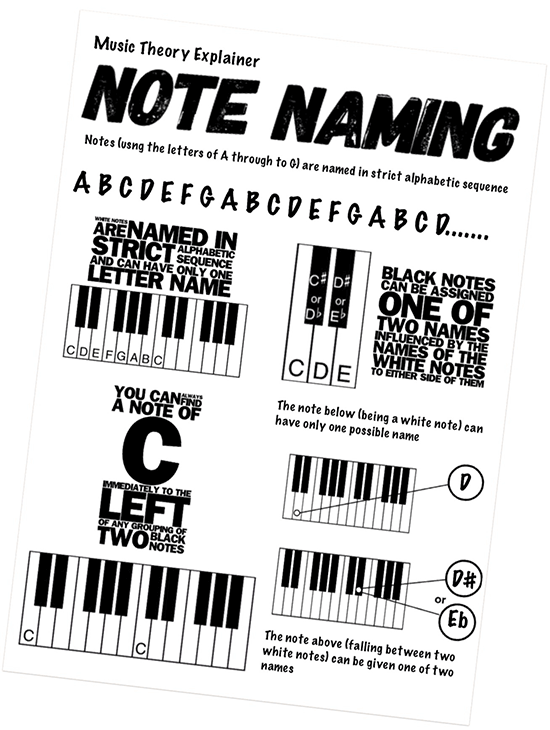
Click the box above to download a free handout (or music classroon wallchart) designed to help you to get the message over to your students
Using the "explainers" alongside our worksheets to "really" get the message across to our students
Below you can see a graphic that shows how our worksheets can be used along with the "explainers" to take students from a "standing start" with regards to music theory to a situation where they can confidently assign the correct name (or choice of available letter names) to any note. This is the ideal start to any study of music theory

Download and print over 400 Music Worksheets
to use year after year
for less than the cost of a
single Paper Based Textbook
$18.00
When students are capable and familiar with the principles behind the naming of musical notes (firstly with access to the note identification chart and then without being able to refer to it) then they are ready to move onto the next topic...........
Music Theory Lesson Plans Topic 2:

Whole and Half Step Intervals
Below you can see one of our worksheets dealing with "Whole Step" and "Half Step" Intervals
You will notice that students are required to build upon and apply the knowledge that they gained when working with the "note identification" materials covered previously. Now, in addition to being asked to identify the name of a note they are further tasked with supplying the name (or potential names) of other notes either a whole or a half step above or below the one originally identified.
This obliges the student not just to research (or remember) the names of the various notes but to apply that knowledge in order to advance their own understanding.

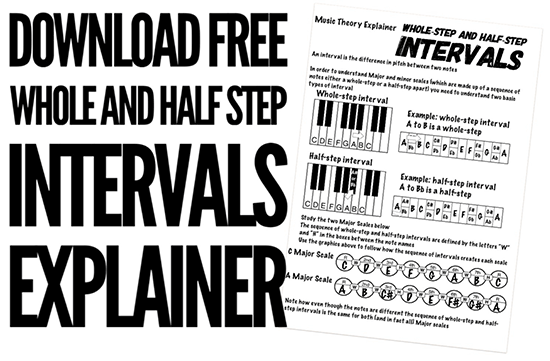
Making Music Theory "stick"
The "explainers" are a great way to introduce and reinforce knowledge and theoretical principles. They work well on their own but work better when combined with worksheets as part of a structured program of study
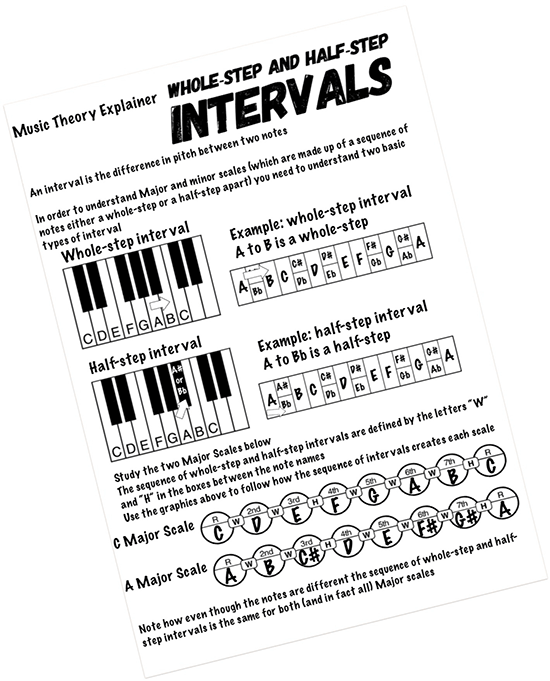
Other intervals can and should be introduced later
Below you can see some of our other worksheets based on intervals other than whole and half steps that can be introduced to our learners at a later stage but as the next topic is major scale construction they need only be familiar with movements of a whole and a half step involved in the creation of major scales

Some of our Workseets based around Musical Intervals
Once our students have a method by which they can identify musical notes we can introduce them to the concept of moving between those notes? We do not need to overload them at this stage by studying the whole range of intervals? In order to understand major (and Minor) Scales all they need to grasp are intervals of a whole and a half step? Our first intervals worksheet concerns itself with these two intervals and after students have successfully worked through it they should be ready to take on the theory behind the construction of the (C) Major Scale
Music Theory Lesson Plans for High School Topic 3:

Using Whole and Half Step intervals to construct the C Major Scale
The Note Identification Chart with a Major Scale Construction (letter names only) Worksheet
Now that students are comfortable with the concept of whole step and half step intervals we can introduce them to the idea that these intervals can be combined in a pre-determined order to create scales? The obvious place to start is with the C major scale? The resources come with a range of major and minor scale handouts which feature varying levels of "support" in the form of keyboard diagrams and boxes in which students are invited to supply the "letter names" of the notes instead of or in addition to the musical notation. For a more detailed look at the help that we provide to music teachers in this are a go to our musical scale construction page

Above you can see the free "explainer" document alongside some of our worksheets designed to help students to become capable of defining the letter names of all of the notes that combine to make up any major scale.
A Music Theory "Game Changer"
Below is a more detailed image of the PDF that will hopefully give you an idea of how it is designed to work in a classroom (or distance learning) situation. The "Explainer" allows students to progress to the point where they can identify the notes in any specified Major Scale and from there to develop an understanding of how all Major Scales (no matter how many sharps or flats are floating around in them) follow the same sequence of whole-step and half-step intervals. I have found this knowledge to be something of a "game changer" for many of my classroom or instrumental students.
When they realise that something that they often regarded as being illogical and way too complicated for them to get to grips with is actually "just a bunch of simple maths and the first seven letters of the alphabet" it can lower their resistance to all things theoretical and provide a great "way in" to the more involved and conceptual side of music

Music Theory Lesson Plans Topic 4:

Using the formulae learned for the C Major scale to construct other Major Scales
Once students become familiar with the formulae used to construct the C Major Scale they can be encouraged to use the same sequenceof intervals in order to construct other major scales. Students (with reference to the sheet which names the notes on a piano keyboard) are required to write the names of the notes of a particular scale in the lower half of each circle. Between each circle the letter "W" (denoting an interval of a whole step) or the letter "H" (indicating a half step) are provided to help students to become familiar with the sequence of intervals involved.

A "letter names only" Major Scales Worksheet in use
After they have become familiar with the identification of the (letter names of the) notes that make up a scale musical notation can be introduced if it is appropriate to your student group/area of study?

Major Scale Construction Worksheets
There are a series of major scale worksheets that ask the students to set out to provide musical notation and to produce the notes involved in the construction of particular major scales. If you look closely at the illustration above you will see that these worksheets feature boxes above the musical staff? the intention is that your students write the letter names of the notes in the boxes before notating the scale (on the staff with each note being placed directly beneath the relevant "box" for ease of marking etc?).
Music Theory lesson Plans Topic 5:

Using Major Scales to Costruct Major Chords
Having mastered the theory underpinning the construction of major scales it is a relatively simple step to help our students to identify the construction of a Major triad using the Root (first) third and fifth notes of the C major Scale to produce the C Major Chord? From this point is should be relatively simple to make our students see that if they can find the notes of the relevant Major scale then they can construct any Major chord?
Music Theory Lesson Plans Topic 6:

Constructing Minor Scales
Just as was the case when familiarising students with the major scale this material concerns itself with the sequence of tones and semitones that go to make up the minor scale
Music lesson Plans Topic 7: Minor Chords

Having constructed the minor scale it should again be a relatively short step to help students to understand how to identify the three notes from within the scale (root,third and 5th) that go to make up the minor triad. There are a set of worksheets which are aimed at inviting learners to identify the three notes of a given chord on a keyboard and to state which type (major or minor) of chord is being displayed.
Music Theory lesson Plans Topic 8:
Chords Within The C Major Scale

Music lesson Plans Topic 9:
Chords In Other keys

Extending the principles encountered above so that they include the chords that can be built from any single Major scale The tonic, dominant or subdominant chords (or Chords I II III IV etc). Whichever way you want your students to understand the material the maths and theory of it all remains the same?
Music lesson plans Topic 10
Understanding key Signatures

Having developed the ability to construct any major or minor scale and to construct the chords that are contained within any key students are more than ready for a series of worksheets themed around Key Signatures designed to help our students to understand the differences (and similarities?) between keys.
Music Theory Lesson Plans
With all of the rules and regulations overlaid on our subject (ks1,ks2,ks3,ks4 etc) it can be useful to remember that the music was there before someone dreamed up the whole key stage thing and will be there long after they've replaced it with the next "big thing"
The subject is more important than the syllabus and we should design our teaching programme around that simple fact?
If our students understand the elements of music and how they work together to create "magic" (and radio jingles) then it should be a relatively easy process to make that fit into key stages for our internal documentation etc? This site is about the music and not the key stages (or whatever) that it is currently (and artificially?) broken up into.
Its not just about music theory though.....
Before we dive into the music theory stuff now is a good time to look at the reality of the situation facing classroom music teachers. The modern music classroom is a very diverse environment compared with the way things used to be and it can be a better than good idea to be prepared to meet your students "on their own turf" which is more often than not located in "Popular Music" forms rather than the more traditional genres typical of the (fairly recent) past
The links below look at materials that we have as part of our download looking at Popular Music Song Forms and the common problem of convincing guitar players to engage with music theory
Download and print more than 400 Music Worksheets
to use year after year
for less than the cost of a
single Paper Based Textbook
$18.00
Buy your music teaching resources in complete safety via any major credit card (through paypal) or directly through your paypal account if you have one. If you choose to use a credit card, rest assured that we never see your credit card details as paypal do all of that for us.
When Paypal receive your payment you will be immediately invited to click a
"RETURN TO MERCHANT"button.
You will be taken to a page from where you can download the products that you have paid for NOW!
In the (rare) event that something should go wrong with the order/download process just email me at robh@teachwombat.com
I will check the order and send you the links that will get you to your stuff.
Cheers! Rob!




